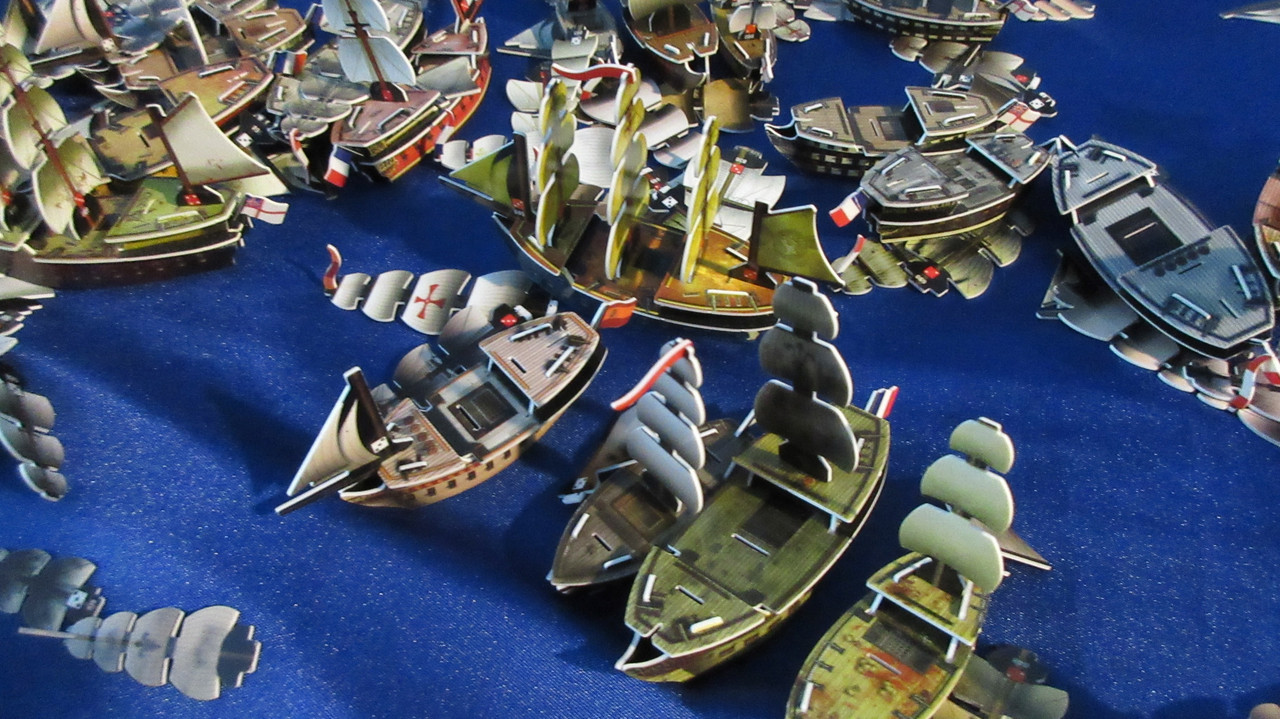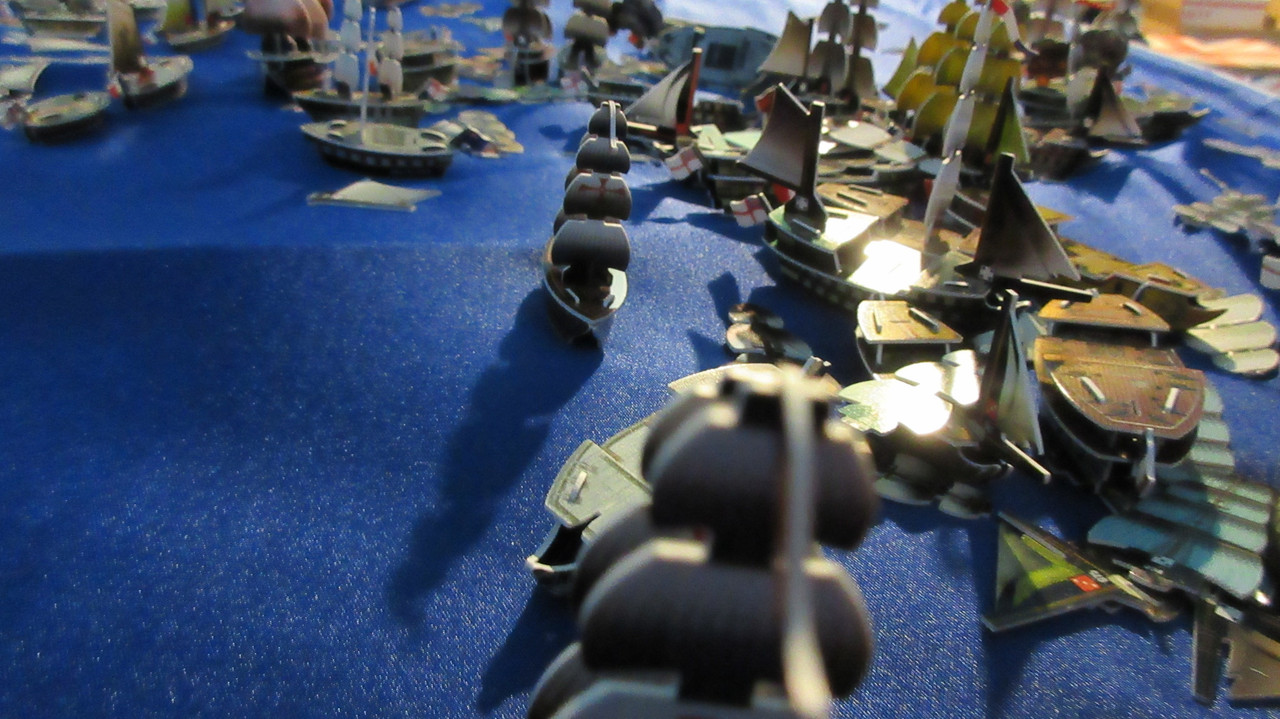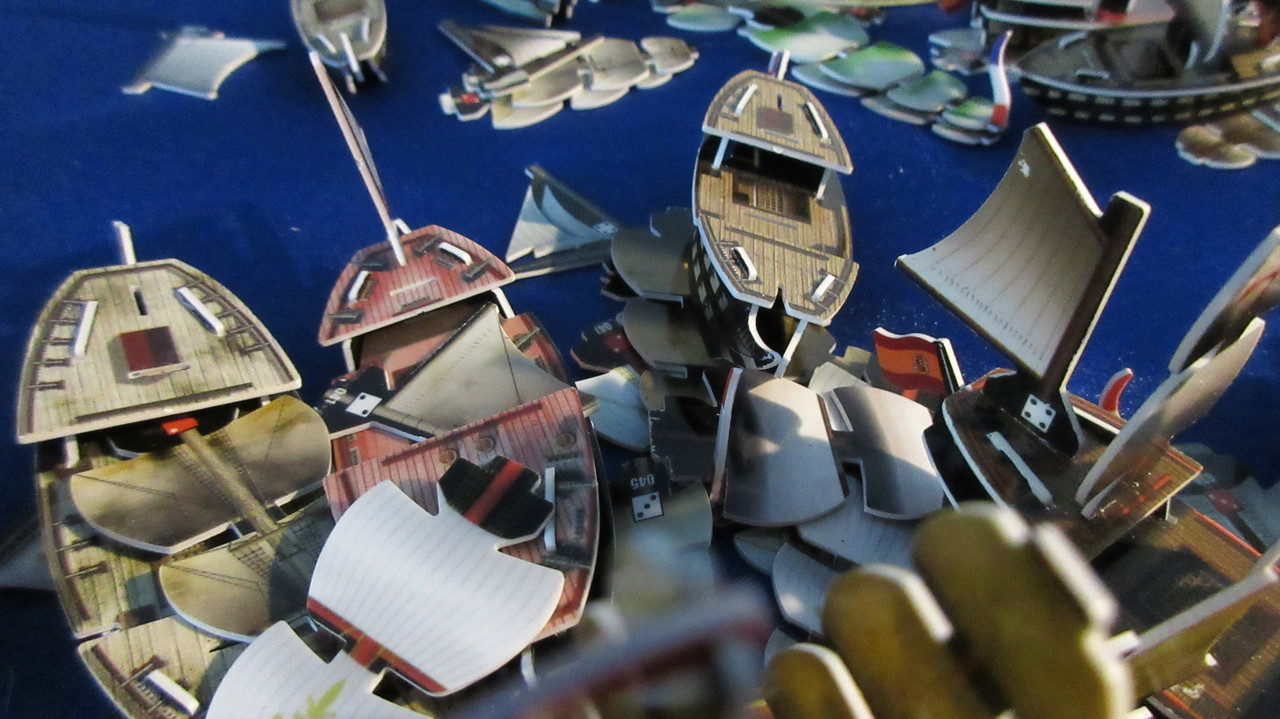Historical Fantasy Scenario Flashback Battle
This is not a regular battle report. Instead, it’s a “flashback” of sorts. I finally got around to doing a Historical Fantasy Scenario (HFS) battle, the first since 2011. I didn’t have time for a full HFS, but this report will give you an idea of what they were like, back in the day. It’s also rather steeped in nostalgia and my personal collection of ships, but that gives it even more of a historical touch.
It was a classic matchup: the English versus the Franco-Spanish. However, certainly not a reenactment of Trafalgar, though that’s something I hope to do someday.
The fleets were as follows:
English: 22 ships of the line and 6 frigates (28 ships total)
Franco-Spanish (FS): 29 ships of the line and 8 frigates (37 ships total)
(65 ships total; considering that some of my HFS battles involved over 200 ships, imagine this battle but three times its size!)
Going back to my Historical Fantasy Scenarios, square rigged ships with 4 or 5 masts were considered 3 decked ships of the line, meaning they generally carried at least 90 guns. For flavor purposes I would count the number of cannons the ship has (based on the actual artwork), and then pile on as many cannons as possible, even where it became unrealistic. This helped the numbers simulate reality more often, and helped me have a lot of SOL’s (ships of the line). In this battle, the English had nine 3 deckers compared to thirteen in the allied fleet.
Both fleets headed towards each other in double lines of battle, with the frigates at the northern end of the lines. The wind was blowing due south. Of course, being the first HFS action since 2011, and quite possibly the last-ever HFS-style battle, this was no ordinary contest, as the particular ships would prove…
The original French flagship, La Magnifique. The leader of the French in dozens and dozens of battles, and the first 5 master I ever owned. The first true battleship, she has been preserved in her original form, when I put the masts in backwards. Her mainmast isn’t broken, but merely loose from the time she was constructed. A true legend in her time, La Magnifique has been brought out of retirement to fight once more!

The exact opposite: France’s newest flagship! Le Dauphin Royal was launched just days ago, and a new generation of French sailors eagerly set sail upon the majestic battleship.
The Magnifique and Dauphin Royal headed the two columns of the combined fleet, but directly astern were many of France’s best ships. Here you can see the intimidating but beautiful Ville de Paris and Superbe in the foreground, while behind them the Argonauta was the only Spanish 5 master available for the day’s action.
This shows the rest of the FS fleet, which is quite impressive.
The backs of the main columns, with the 2 deckers eager to form lines of their own or join one of the main columns.
The French frigate squadron, with the ultra-fast Le Mercure in the lead. The Mercure shared the title of “fastest ship afloat” with the pirate schooner Raven back in the old days. Off her starboard quarter sails Le Republicain, a ship whose gun crews are among the best in the French fleet. Behind them are mostly newer arrivals, eager to prove themselves in such a rare opportunity that this was.
One last look at the French for the time being:
Her Majesty’s Navy: 28 of England’s finest warships, out to defend their dominion, which is the world’s oceans. Unlike the French, their strongest column is the one to windward.
Heading the English line: HMS Titan and HMS Dreadnought. The third ship is one the allies didn’t want to see: HMS Gargantuan. Back in 2010 and 2011, times of extremely frequent and intense warfare, the two Gargantuans often dominated the seas as England’s flagships. With her sister ship in drydock and this Gargantuan demoted from the front of the line, she holds a somewhat less powerful position than she did in her glory days. However, she still commands immense respect, especially from those newbies in the allied fleet who would be unwise enough to forget the tales of past conflicts.
England’s frigate squadron. While small back then too, it was never the reason for England’s victories at sea.
A sight the allies dreaded even more than HMS Gargantuan – my first two English ships EVER! Similar to the Magnifique and Gargantuan, HMS Lord Walpole and HMS Birkenhead have been involved in countless battles, and these two have almost always been on the winning side, often teaming up to surround and pulverize larger ships. Probably no two ships in my collection have dealt as much damage as this duo.
Is there a prettier sight to be seen? (other than this in real life haha)
It’s time for WAR!
Some of the French 2 deckers begin to join the lines, while the Spanish 3 deckers disobey orders and fail to join the windward column:
The English lines of battle are in accordance with their battle plan, but will their numerical inferiority doom them?
Open fire! Battle is joined! The Titan and Magnifique exchange furious broadsides, with the Magnifique losing her jib.
The Dauphin Royal fires her cannons for the first time as the Titan comes under fire from both sides. Just beyond them, the frigate battle has begun. The Mercure got ahead of herself and overestimated the speed of her fleetmates, and lost her foremast to a well-placed shot from the Saint James, who then rammed the French schooner at full speed.
England’s flagship has already lost two masts, but she moves on to face Le Superbe:
The Dreadnought punishes the Dauphin as some of the French ship’s shots miss high due to an ill-timed wave.
The Magnifique and Gargantuan meet yet again, but this French admiral has heard the horror stories of past wars and looks to break off the engagement. Up north, the arrival of the other French frigates has signalled a shift in that theater of the battle.
The powerful Republicain comes to the aid of Le Mercure while the Bonifacio dismasts the Minerva.
That swell in the middle of the battle has disrupted things for a moment, but both fleets are in no mood to surrender to the weather!
As per the English strategy, HMS Titan steers away from the allied windward column. The Argonauta and Gaule are afraid of hitting their French comrades in the leeward column, especially when aiming for the rigging, and many gun crews hold their fire temporarily.
In the English leeward column, the Orkney and Burma are slow to get into action. At the upper right and behind the Gargantuan sails HMS Success, a critical part of many English victories. They were especially important when I had 3 of them, but the other two have since been traded to other admirals!
With the Magnifique out in front of the rest of the French column, and the slow Ville de Paris lumbering behind, the captain of the Gargantuan saw his chance. Seizing the initiative, he went with the wind and took his ship out of the line, breaking the French line in the process. The Gargantuan raked the Ville de Paris by the bows, wrecking two of her masts.
With the Titan off fighting the Superbe and the Gargantuan sailing south, the Dreadnought was fighting the southernmost allied 3 deckers by herself. The English roped and grappled their ship to the Dauphin Royal, lashing the two ships together. This caused panic aboard the Argonauta, who soon crashed into the Dauphin’s starboard quarter! The force of the collision carried the Argonauta into the Dreadnought as well.
Here the French have a numbers advantage, but the inexperienced Spanish contingent and fears of friendly fire have led to a stalemate in these early stages of the battle.
The Magnifique lets loose an angry broadside, quickly crippling the Oxley. The next ship in the English leeward column is HMS Concorde, which has one of the fastest-firing crews in the English fleet.
With surprising speed, the Lord Walpole and Birkenhead arrive in the action! The Lord Walpole gives a thunderous broadside to the Delacroix, while the Birkenhead follows.
The middle of the battlefield, where despite the high losses in crew the capital ships are faring relatively well.
The Lord Walpole’s captain was overly aggressive, and tried to go inside the French line. His ship was nearly quick enough for the maneuver, but the Neptune’s jib caught in his rigging! A line was severed, but the Neptune was already colliding with the Lord Walpole’s stern, causing a bit of damage and heeling the ship out of the water.
In the center, the Superbe and Titan have become locked together in an epic duel. At the right, a line of 6 ships deep dominates the battle, with the line alternating French-English at 3 ships each. HMS Success and La Gaule are the latest entrants.
The frigate battle was not going well for the English:
In a rare instance of French seamanship, the Magnifique broke part of the English line to rake two ships at once, causing devastation! At this point she was by far the most easterly allied ship, having basically reached the end of the English formation.
Some of the smaller French SOL’s are set upon by larger English ships:
As chaotic as the battle was getting, a lot of ships had yet to enter the action!
With this overhead shot, you can see that it’s still roughly a line-of-battle affair, but the sheer carnage is threatening to turn things into a pell-mell action.
The battle continues to shift slightly to the south, partly due to the wind.
At the lower right, the Provence would soon become the first allied ship to surrender, while the Intrepide has suffered a double broadside from the Cheshire and 3 decked Burma.
The Lord Walpole has rounded the Neptune only to encounter the L’Heros, while the Birkenhead continues against the Neptune. At the right, the Orkney and Burma have made short work of the Delacroix.
A huge broadside from L’Hercule brings down the King Edward’s mainmast:
The exhausted crew of the Dauphin Royal finally broke free of the Dreadnought, only to run into raking fire from the fresh HMS Leicester!
Only three English frigates still have masts standing, as the French have outmaneuvered and outgunned them from the start. It may have helped that there weren’t any Spanish frigates, as many Spanish SOL’s have yet to enter the main battle or have caused complications for the allies.
Many allied ships have turned southeast in an attempt to join battle, but it may be too late for some of them.
The Magnifique has finally broken free of the fighting to give her crew a short rest, but what she sees is not pleasant: superior English gun crews have led to their dominance in the southern area, while the central area features many shattered French capital ships. As the English columns moved south to crush the French, the Spanish ships with the weather gauge found it difficult to enter the battle, between the logjam in the center and the frigate battle to the north.
The Lord Walpole and Birkenhead sight the Magnifique to the east, and make a beeline towards the flagship, confident in their gun crews.
3 deckers from both sides engage. The Scipion fires upon the Titan, which is now aflame.
The other Spanish 3 deckers finally enter the battle, and the Success is dismasted.
The Concorde duels with the Ville de Paris. Behind them you can see the Hercule and Leicester beating each other to pieces in an evenly matched fight. The fresh HMS Victoria has engaged the battered Dauphin Royal.
The frigate battle is already over! The Saint James was outnumbered 3 to 1, and couldn’t make up the difference. The large crew of the Bonifacio took care of the Patagonia, while the other French frigates surrounded their English counterparts.
War at sea:
Here is generally where the battle reached its peak:
History repeats itself! The battle for the ages: La Magnifique vs HMS Lord Walpole and HMS Birkenhead.
The Ville de Paris was winning her battle against the Concorde, but here the Ajax has begun to fire upon her starboard quarter. At the left, two English 64’s surround a Spanish 3 decker.
Utter devastation. The Hercule and Leicester have dismasted each other but continue to fight. The Dauphin Royal is close to striking her clors to the Victoria. Behind them, the Argonauta has dismasted a small English SOL before being set ablaze by the fresh Belle of Exeter. At the top of the frame, the Dreadnought is slowly winning a battle of attrition against La Gaule, while the French frigates regroup after the English frigates surrender.
The Saint James was in no condition to be taken as a prize, and the French sunk her.
Overeager to get into battle, the Auguste rams one of her allies!
The center of the battle has become very densely packed, with La Valois as the latest entrant. Her and her sister ships are veterans of many battles, but that may not help her against the sheer firepower of HMS King Edward. At the right, the Titan has lost her final mast to Le Superbe, but refuses to surrender.
At the southern edge of the battle, the English have captured 3 French SOL’s.
One of my first four ships ever, the Asesino de la Nave makes the showdown a battle of the classics! The Birkenhead lies derelict, but the Magnifique has been shot to pieces and has half of her crew killed or wounded.
The English continue to clean up in the south, capturing two more French ships. Just north of them, La Toulouse has been dismasted by the mighty HMS Gargantuan. At the right, HMS Victoria delivers a broadside through the stern galleries of the Matthias Vospero.
Carnage in the center:
An ominous sight: the fire aboard the Argonauta spreads, and she drifts south with the wind, crashing into the stern of the Dauphin Royal.
Total carnage!
The entire battlefield, showing the scope of the conflict:
Soon afterwards, ships begin surrendering.
The Argonauta exploded! When the fire reached her powder magazine the big 3 decker blew up, with the force of the explosion capsizing the Dauphin Royal and Hercule and moving the Leicester. The Lord Walpole and Ville de Paris were set aflame by the burning debris.
HMS Success is the first English SOL to surrender, while the English force the Neptune and Delacroix to finally strike their colors.
One of my favorite pictures of the battle, showing the action at mast-level and the beautiful shimmering ocean water.
The end is near…
In a scene of unimaginable carnage of death, the Titan and Superbe refuse to surrender, though their rates of fire have decreased significantly from the battle’s start.
Completely exhausted, both sides retire:
The Magnifique finally surrendered, as did some other French ships.
The Spanish, having had trouble geting into the battle early on, still have some ships with all their masts standing, but the new allied commander has ordered a retreat.
A final look at the debris, carnage, and what may be my last-ever HFS battle:
The English were victorious! They had captured 12 enemy ships, and sunk 3 of them. The Franco-Spanish allies had captured the entire English frigate squadron as well as one ship of the line, while sinking the Saint James, for a total of 6 ships captured and 1 ship sunk. The English had lost 50 masts in the day’s action, while the Franco-Spanish lost 74 masts. At the close of the battle, the English had 17 seaworthy ships (ships with at least one mast still standing), compared to 21 in the allied fleet. However, only 13 of those 21 were ships of the line, and almost none of them 3 deckers, while the English had all 17 ships of the line and a morale advantage. The English had a superior strategy, hitting the French leeward column very hard while delaying the windward column and the Spanish reserve from coming up to help. They also used superior gunnery to prevail. The allies were not entirely coordinated in their efforts, and the insubordination and general lack of ambition in the Spanish fleet was partially to blame in their loss.
I hope this gives you a better idea of how Historical Fantasy Scenarios were done. Of course, collecting gold, launching ships, expanding harbors, and avoiding battle were all major parts of HFS’s, but the battles were the most memorable part. I would say that this battle size was about average for an HFS, though sometimes the number of masts lost was greater or less depending upon the nature of the battle. Of course, this battle pales in comparison to this one, which may be the biggest battle I’ve ever done. That battle featured around 200 ships and almost exactly twice as many fallen masts, so you can begin to imagine the carnage.



















































































































